Discover the Island Treasures of Île de la Cité
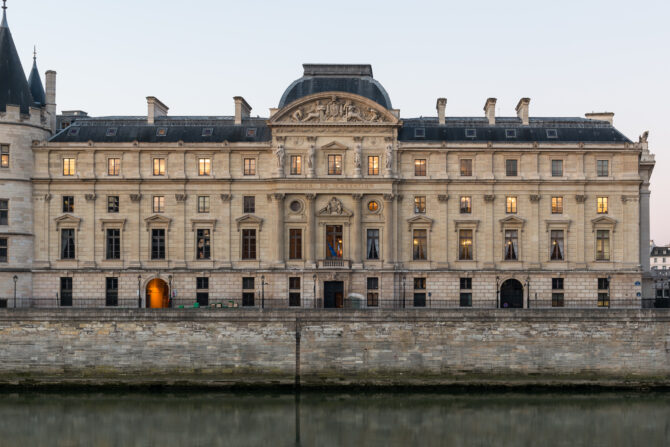
- SUBSCRIBE
- ALREADY SUBSCRIBED?
BECOME A BONJOUR PARIS MEMBER
Gain full access to our collection of over 5,000 articles and bring the City of Light into your life. Just 60 USD per year.
Find out why you should become a member here.
Sign in
Fill in your credentials below.
The Île de la Cité is so much more than just Notre Dame. Yes, honoring the reconstruction work of the fire-devastated cathedral with a visit can be rewarding, but there is so much more on the island to explore and learn. The city of Paris started on Île de la Cité. It continues to be an active center of administration for the city, and visitors can also explore Paris’s oldest street, bridge and probably the world’s oldest hospital. Plus, the area just around the island is fun to see and visit including buying paint from the same store brand used by some of the Impressionists to petting a giant turtle alongside the Seine.

Notre-Dame during the renovation of 1845-1863. Émile Harrouart, around 1860 – Musée Carnavalet
Courts and Cops
The island has always been a place of courts, justice of the times and police stations. During the Roman era, the island hosted the courts of justice which was located near the present flower market (Marché aux Fleurs) along the Rue de la Cite and the metro station next to the market. The French kings built the huge medieval Palais de la Cité as their royal palace, along with Sainte Chapelle chapel and the Conciergerie, a famous prison which operated until 1914. The Parliament of Paris was the center of court administration and law courts and was the site of trials during the French Revolution, including Marie Antoinette’s. As the Palais de Justice, it comprises the Court of Appeal of Paris and the Court of Cassation, the supreme court for civil and criminal cases- France’s highest court. The Court of Cassation has seen an array of trials from the Bataclan to current events. (A few years ago, the city’s Palais de Justice moved to a new modern building, designed by architect Renzo Piano in the Batignolles district of the 17th arrondissement, where the majority of judicial cases are tried.)
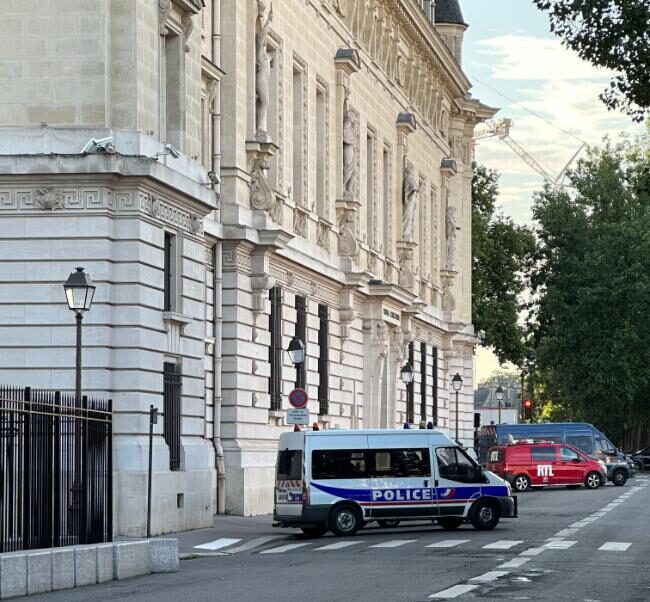
Police cars protecting the entrance along Quai des Orfèvres. Photo: Martha Sessums
The building includes the entire width of a large section of the island between the two river quays from Boulevard du Palais to Rue de Harlay. Trial activity can often be observed around the court buildings in the morning or late afternoon but especially along Quai des Orfèvres and the main entrance along Boulevard du Palais which are the entrances for prisoners or people involved with trials. If the trial is making the headlines or involves serious criminals, the area is often surrounded by police cars, motorcycles and armed officers with rifles and guns blocking the road. Depending on the importance of the trial and the accused and accusers, the entrance along the quay is blocked off so unauthorized persons can’t pass until all trial personnel have safely arrived or exited in police cars or vans with blue lights flashing and horns blaring.
Currently there is renovation work along a portion of the south and southwestern sides. Along the workspace perimeter, there is a display of some history points of the building including movies filmed at the 36 quai des Orfèvres location. These include Georges Simenon’s crime novels and many other feature films.
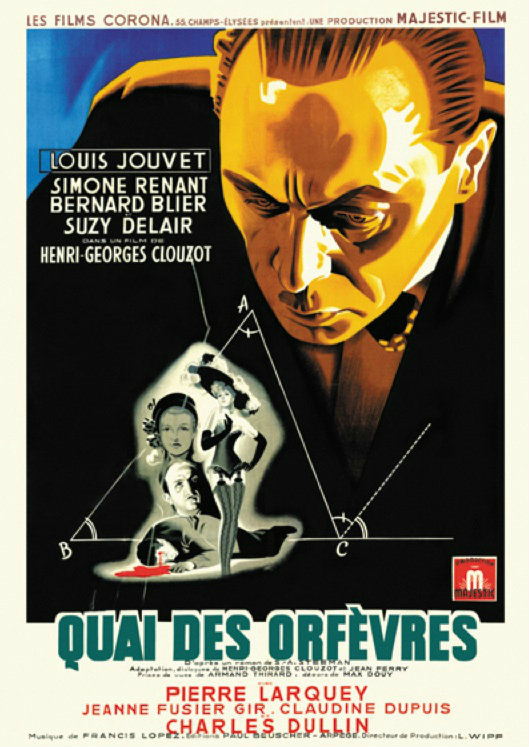
Poster for the 1947 film “36 quai des Orfèvres”.
Visiting the inside of the Palais de Justice is possible by ordering tickets here. The tour is all in French but one can experience a view of the elegant hallways, a few of the courts and the grand courtyard. A visit to Sainte Chapelle is also available to see its gothic architecture and colorful stained glass. Any visit behind the Palais du Justice walls is a step into old and current history; you can also experience this just by looking up into the rooms of the Palais from the street and seeing ancient gold and colored ceilings with modern light fixtures in rooms used by today’s lawyers and judges.
The Préfecture de Police is located on the block next to the Palais de Justice and takes up a section of the block between the Boulevard du Palais and Rue de la Cité overlooking Place Louis Lépine and the flower market. Police, lawyers and others are seen coming and going as happens in any police station. Unless you have administrative business, this is a building one doesn’t want to see inside, especially if wearing handcuffs.
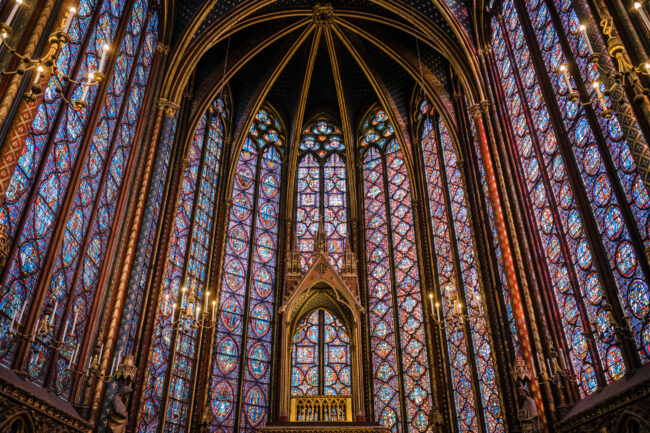
The apse of the upper chapel, Sainte Chapelle. Photo credit: Oldmanisold / Wikimedia commons
The fun police station to walk by and sneak peeks at is Le Service des Compagnies Motocyclists located on Rue Chanoinesse, a block away from Notre Dame. There are 197 motorcycle police who escort high ranking French officials, firefighters, medical vehicles and help with the transfer of prisoners. They are the officers watching for traffic violations too.
The big doors of the building are often open with police standing at the entrance. In the background are many big, powerful motorcycles awaiting an officer to ride the streets of Paris. The police at the entrance are friendly and will answer a few questions – in French mostly – but they are on duty protecting the site and will not be too distracted.
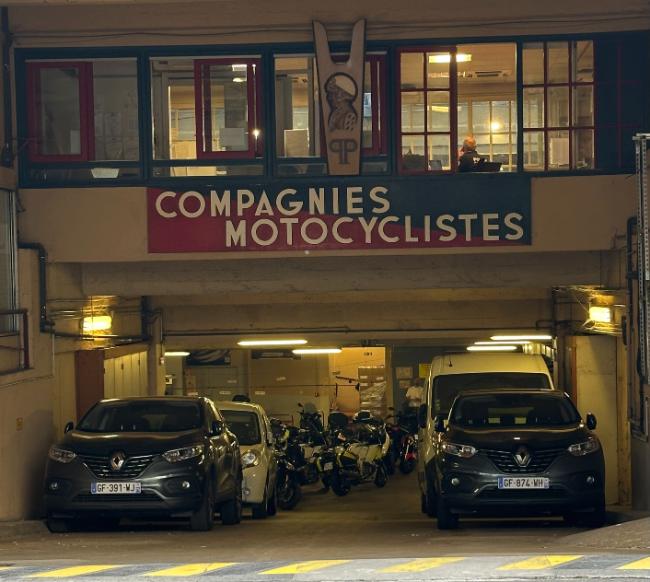
Motorcycle Police station. Photo: Martha Sessums
Hôpital Hôtel-Dieu
While standing in the massive lines in front of Notre Dame, check out Hôtel-Dieu, the oldest hospital in France and probably the oldest continuously operating hospital in the world. It was founded by Saint Landry in 651 AD on the southern side of the island, but the first official records of the hospital begin in 829. It was the only hospital in the city until the beginning of the 17th century and was ruined by fire several times and rebuilt. The last time was on the north side of Notre Dame’s parvis between 1867 and 1878 when Haussmann renovated Paris.
It has a history of helping the poor which resulted in overcrowding and inadequate conditions but worked to overcome the issues. Ultimately it played a central role in medical instruction and research including vaccinations, diagnosis of illnesses using tools such as stethoscopes and understanding the cause of diseases.
Today it is a modern, specialized hospital dealing with public assistance, emergency cases and surgery for central Paris and is a leader in research and the prevention and treatment of diabetes and ophthalmology (eye disorders). It also provides specialized consultation for sports medicine, cardiovascular, sexual health/trauma and general psychiatric support. During the covid pandemic, it was one of many places to receive current vaccinations.
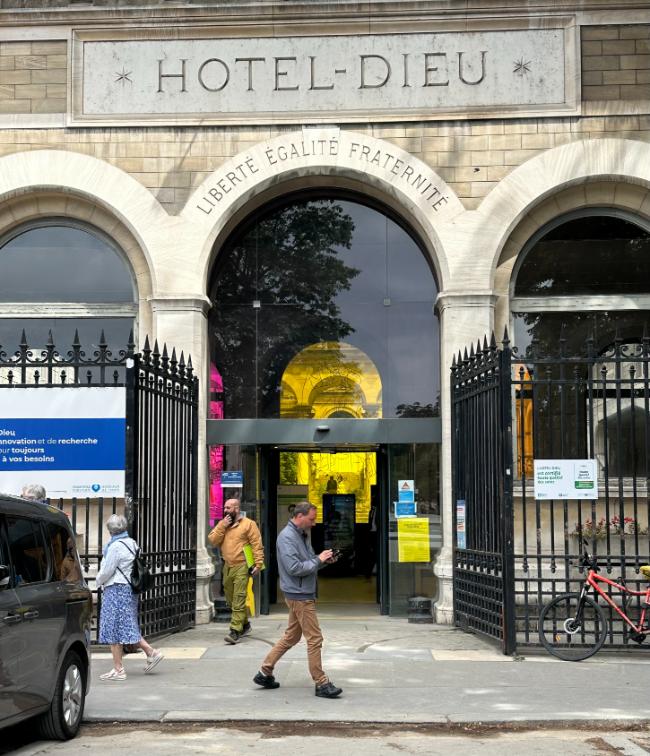
The entrance to Hôpital Hôtel-Dieu. Photo: Martha Sessums
Place Dauphine
Place Dauphine was the idea of Henry IV in 1607 and was named for his son, the Dauphin of France who became Louis XIII. The triangle space at the western end of the island across from the Palace de Justice accesses the middle of the oldest bridge in Paris – Pont Neuf – which connects the left and right banks of the Seine.
It has always been a place of housing, although it has changed from royals to workers and back to expensive apartments that aren’t quite royal but are high end for the island and Paris. Today it is an active place for lunch in the center park area outside several restaurants where one can watch people playing pétanque or walking their dogs. It is away from crowded Paris and offers a sense of relaxation while enjoying a glass of wine, observing the trees, lovely houses – some with rooftop gardens – and friends laughing while playing pétanque. Even street artist Invader has found the square with a white and red character smiling at the activities on Place Dauphine.
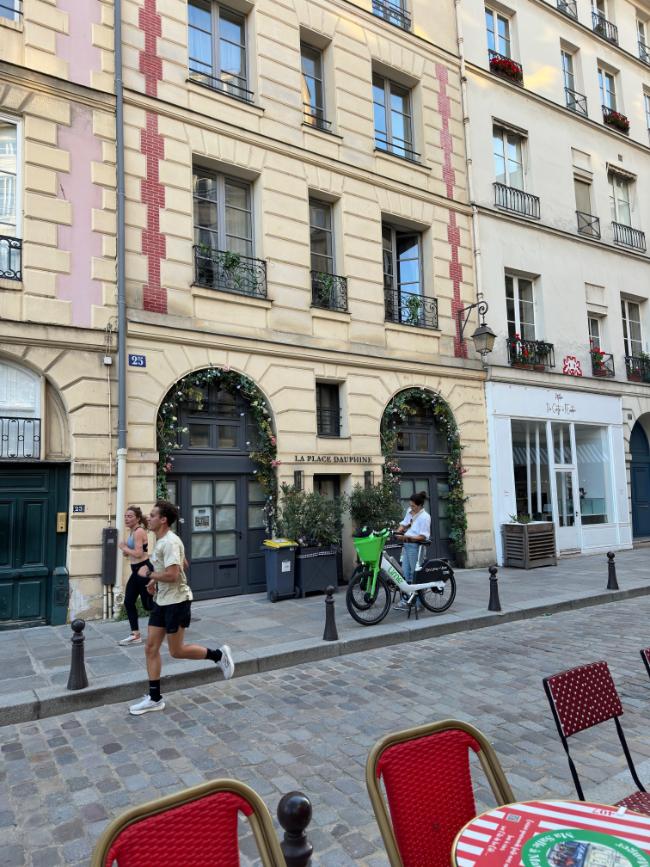
Place Dauphine with runners and an Invader. Photo: Martha Sessums
Enjoying the View at the Western Tip
One of the best ways to enjoy Paris is to find a place to sit and watch the action. A great place to enjoy the Île de la Cite is just off the island. On the other side of the Quai du Louvre right next to the Samaritaine department store is restaurant Cova with plenty of outdoor seating to enjoy an aperitif. Watch the island’s building silhouettes and windows as the light changes. Enjoy the traffic crossing Paris’ oldest bridge as trucks deliver, taxis cruise and people walk carrying big bags full of goodies from Samaritaine. There is also a Paris fashion show to enjoy as the shoppers show off their leopard print scarves and purses, wide leg jeans or skinny pants, messy hair studded with interesting clips and hair ties and shoes ranging from Veja baskets to silver Adidas to kitten heels.
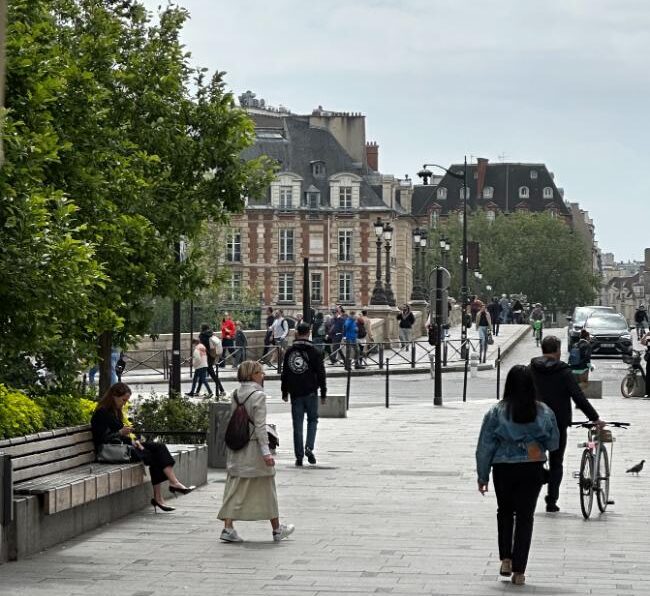
Watching Île de la Cité from the Cova restaurant area. Photo: Martha Sessums
Charvin Arts Store
The Charvin Arts store is also just off the western end of the island. It began as an art store in Cannes that supplied painters such as Cézanne, Bonnard and Pierre Ambrogiani. In 2000, Laurence and Bruno Charvin discovered the art supply store and bought it. They moved it to Paris where they sell high quality oil, acrylic and gouache produced in France with the best, natural materials on the market. The store is located on the Quai des Grands Augustins right at the corner of the Pont Neuf as it leads onto the left bank.
The store has an amazing selection of paints, watercolors, brushes and knives, drawing pencils and paper notebooks. It is full of treasures to give to friends, family and yourself, all with a connection to painters whose work is loved, admired and hanging in museums throughout the world. What an inspiration for any artist or artist-to-be.
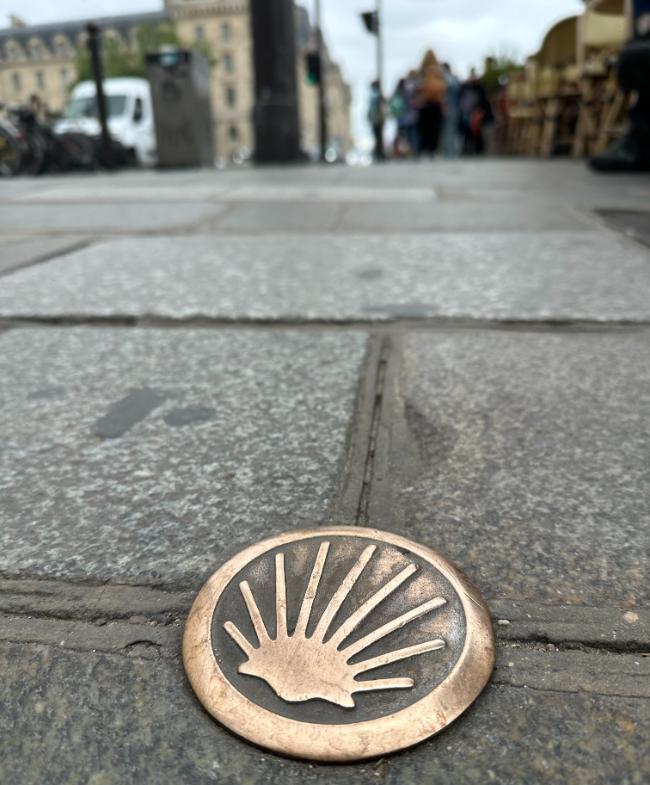
Santiago de Compostela marker on Rue Saint-Jacques. Photo: Martha Sessums
Paris’ Oldest Road – Rue Saint-Jacques
Another place to enjoy the island’s history is the ancient road Rue Saint Jacques. It’s the road that starts in front of the parvis of Notre Dame, crosses the Seine along Petit Pont and enters the Left Bank. It was the main road leading into Paris in Roman and medieval times and is also the starting point for pilgrims leaving Paris to walk the Santiago de Compostela pilgrimage route to Spain (also known as the Chemin de St Jacques).
Look down the busy road and imagine people walking or riding horses or wooden wagons as they delivered goods to the ancient heart of Paris. Imagine Roman soldiers on horseback with shoulder robes flitting in the wind as they made their way into the city returning from some battle. It was the street where the first printing press produced books in the 1470s and became a location for many booksellers and printing stores. The currently busy street is key to understanding the old and new of Paris.
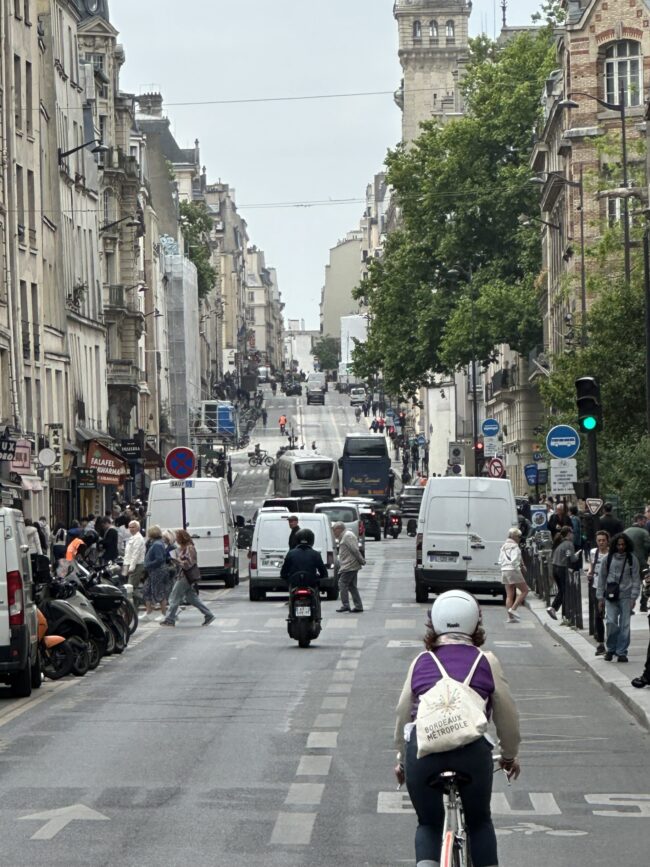
The view down Rue Saint-Jacques. Photo: Martha Sessums
The Island Parameter
Walking along the parameter of the Île de la Cité, or just beyond, is a great way to see the island. Several boats are moored along the Seine where one can appreciate the view while enjoying a meal or drinks as the river flows along. Restaurant boats can be found at both ends of the island to watch the activity at Notre Dame or the quieter western end to watch runners, walkers and bicyclists along the Voie Georges-Pompidou. Cars were eliminated from the road in 2016 and it’s now a popular place to exercise and enjoy seeing the river and islands with no fear of cars.
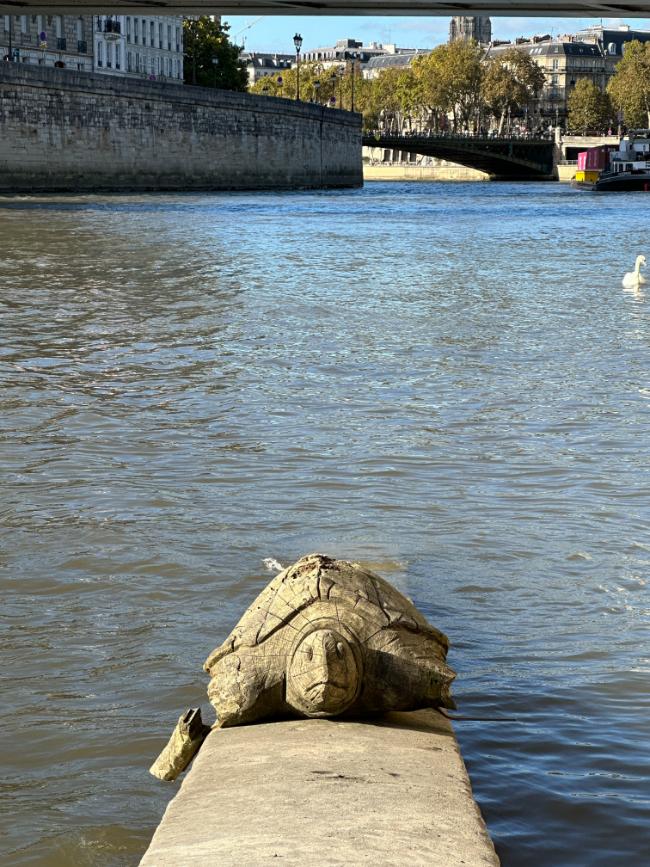
Wooden turtle on the Seine. Photo: Martha Sessums
Eastern Bridges and a Turtle
The bridges at the eastern end of Île de la Cité have very different traffic than the other bridges. The Pont de l’Archevêché is located at the end of Notre Dame’s park and leads to Rue des Bernardins on the left bank or up the northern side of the island. The bridge is a great location to watch the current work on Notre Dame. The second bridge is Pont Saint-Louis that starts at the end of Rue de Cloitre Notre Dame. Car traffic free, it links the Seine’s two islands and is often full of musicians and singers entertaining the crowds. It provides a great view of Notre Dame plus the eastern part of Paris with its tall buildings.
Look down on the Île Saint-Louis quai that leads into the Seine. On the edge of the boat ramp sits a large, wooden turtle. He has been there for several years and shows the damage of being under water when the Seine rises, including a missing left leg and a damaged right leg. The history of the turtle is unknown, as is the artist, although rumor is the turtle arrived during the pandemic. He continues to hang on the ramp waiting to be petted and photographed while watching over the Seine traffic moving downriver. Cross over to Île Saint-Louis, walk down the ramp and pet the turtle while enjoying the view of the Île de la Cité. Quasimodo would have done the same.
Lead photo credit : South front of the Cour de Cassation, The Palace of Justice, facing the Seine. Photo: Daniel Vorndran / DXR/ Wikimedia commons
More in Île de la Cité, notre dame, Palais de Justice, Paris bridges



REPLY
REPLY